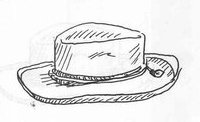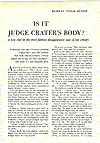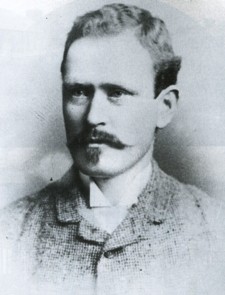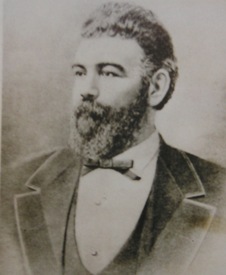Who’s Who in the United States often rewards the casual reader because it reveals how its subjects view themselves. In the 1905 edition, the great J. Pierpoint Morgan modestly calls himself a banker and William Randolph Hearst a publisher. John W. Gates bluntly calls himself a capitalist. He lists no honorary doctorates, philanthropies, or hobbies. A reckless bravo who won and lost fortunes on the toss of a coin or the turn of a card, he had entered American folklore as “Bet-a-Million” Gates, who flinched at no stakes and feared no odds.
In 1905 Gates was stumping back and forth on the platform beside his private railroad car at Kansas City Union Station when a man introduced himself and invited Gates to play a game—any game—with him. Gates said he didn’t plaly for small sums, and anyway he was leaving in five minutes. “Show me the money,” he said. The challenger took out $40,000 in one-thousand-dollar bills. Gates reached into his pocket, took out a $20 gold piece, and tossed it into the air. “Call it,” he said. The local called heads. Both looked at Gates’s wrist. It was tails. Gates grinned, pocketed the bank notes, and stepped into his car. The loser became a local celebrity: the man who had lost $40,000 in forty seconds to “Bet-a-Million” Gates.
Gates was born poor in 1855 in Turner Junction, Illinois, passing through which, on his American tour, Charles Dickens had written, “Nothing ever has or ever will happen there.” Gates grew up a fat, angry troublemaker, driven by envy and class resentment. He was expelled from Sunday school for robbing the collection box. In his early teens, when he and his gang were skinny-dipping, a group of girls from school sneaked down to the riverbank, stole their clothes, threw them on the roof of the schoolhouse two hundred feet away, and ran back to tease the boys. Gates strode stark naked out of the river and “waved himself” at the girls as he went for the clothes.
In 1873, Gates watched a demonstration of how a new invention, barbed-wire, restrained cattle. Colonel Ike Ellison, who owned a wire mill at De Kalb, Illinois, offered him a salesman’s job at thirty dollars a month plus commissions. He took it: being on the road as a traveling salesman would be more fun than staying behind the dry goods counter in Turner Junction.
By day, Gates produced rodeos in the plazas of dusty cowtowns, building arenas of barbed-wire that restrained the wildest steer. At the end of his first week in San Antonio, he had sold every piece of steel in his possession except his corkscrew. By night, he was doubling and tripling his commissions at poker, for even then he possessed what Arabs call baraka, the true luck.
Within a decade, he had built his own wire mills, become Ellison’s boss, and become famous for his willingness to wager the largest stakes on the weirdest things: the weight of the next man to enter the room, or which raindrop would first reach the bottom of the window.
He won the nickname Bet-a-Million after his horse, Royal Flush, won the Steward’s Cup at Goodwood, an exclusive English race track. The wire services claimed he had won $1,000,000 (he had actually pocketed only $600,000). Gates loved newspaper publicity. His wild betting and extravagance were great copy beloved of desperate editors and a public clamoring for details of his incautious spending.
Once, to surprise his wife, Gates bought a townhouse near the Waldorf for $300,000. With the residence came the former owner’s personal valet, Francis, whom Gates instructed to furnish the premises. Pausing only for a quick one at the Waldorf bar, Gates and Francis visited the Wildenstein Gallery in search of paintings for the downstairs rooms. They were shown a vast assortment of paintings in the academic style—the taste of the time—largely battle scenes of the Napoleonic Wars, all in massive gold frames.
“What do you think of them, Francis?” asked the master. “Are they the McCoy?”
“I believe them to be authentic and of reputable genre,” said Francis.
“Tell the fellow to pack them all up and send them over.”
He became richer still by buying industrial lame ducks cheap and combining them into new corporations, overvaluing their assets, and manipulating the price of the stocks with insider information. Some of his companies became famous, such as Diamond Match (the match trust) and Nabisco (formerly National Biscuit, the cookie trust). He helped finance the Plaza Hotel, and when it opened in 1908, he and his wife rented a lavish apartment for $40,000 a year.
He became squat, even saurian, with a huge dragoon mustache, and his language was coarse. His private life was a succession of whores, “artist’s models,” and actresses. His manners were boorish and his personal relations a matter of gruff discourtesy, save where he might profit by a show of good manners or generosity.
His taste in interior decoration, lacking the disciplined self-restraint of Ludwig II of Bavaria, consisted largely of exploding gold over every imaginable interior surface and the display of biologically correct bronze nudes.
He was a denizen of the old Waldorf-Astoria Hotel, holding court in a leather arm chair at a heavy oak table in the oak-paneled Men’s Bar. On days when the stock market was quiet, he played bridge for $100 a point. The journalist Albert Stevens Crockett wrote in his memoirs of a young politician who, invited to sit in on one of Gates’s card games, assumed that Gates’ statement that they were playing for “one a point” meant a dollar. The young man walked away from the table a winner, expecting a check for $330. He nearly fainted when he received one for $33,000 in the next morning’s mail.
And Gates ate, diligently packing on the poundage. It was the 1890s, the age of the lobster palaces such as Rector’s, Jack’s, Churchill’s, Shanley’s, and Bustanoby’s, restaurants of lavish decor and food of heroic quantity, variety, and expense. A late exemplar of that kind of eating was Henry George—not the social reformer, but the 300-pound head carpenter of the old Metropolitan Opera. One Christmas Day, Mr. George wandered into Bleeck’s, where he sat down to a dozen double Southdown mutton chops, a four-pound chateaubriand, and two roast capons topping five pounds each. When he ordered a Kentucky ham and six mince pies for dessert, Bleeck instructed the waiter to cut him off. “I don’t want him dead on the premises,” he explained. Mr. George shook an angry fist at the management and stamped across the street to the Greek’s, where “they wouldn’t turn away a man hungry at Christmas!”
Early in 1896, Gates learned that J. Pierpont Morgan was negotiating with Andrew Carnegie to create United States Steel, the world’s first billion-dollar corporation. Gates hated Morgan: they distrusted each other; they had clashed in the stock market; but most importantly, Morgan was suave, masterful, and secure, the kind of aristocrat that aroused Gates’s Jacobin instincts.
Gates merged seven Illinois barbed wire factories into the Consolidated Steel and Wire Company. A few months later, he added seven steel mills and created the American Steel and Wire Company of Illinois, issuing $24,000,000 in beautifully engraved stock certificates. Less than a year later, having repeated this process in the East, he had his new company, American Steel and Wire of New Jersey, buy up the old for $36,000,000. Only old fogies sneered at the old firm’s fifty percent increase in value within eleven months. To the younger generation, it was undoubtedly the synergy of the plants with Gates’s executive talents.
Gates’s private car was rolling through Ohio one night when one of his associates glanced out the window long enough to recognize where he was. “There’s a nice plate mill in the next town,” he told Gates. “Why don’t we stop off and buy it?” Gates and his men, all of whom had been doing things with cards and bottles, located the home of the mill owner and routed him out of bed long after midnight. They suggested $200,000 as a fair price and offered to write a check then and there.
“But my plant isn’t worth $200,000 and anyway it isn’t for sale,” protested the sleepy owner. “Why don’t you gentlemen sober up and go home?”
“Let’s not be small about it,” Gates said. “We’ll make it $350,000.”
Morgan finally invited American Steel & Wire to join U.S. Steel. Gates, knowing Morgan needed wire mills, named an unreasonable price. Negotiations were joined.
Now, the skin of Morgan’s nose was affected by an incurable acne rosacea, which left it red, enormously swollen, and pustulous. Morgan had learned to live with it, his self-loathing channeled into a hatred of mirrors and photographers, although an occasional disgusted glance from a passerby still disturbed him.
Gates and his partners stumped into J. P. Morgan & Company for the final talks. Morgan had delegated the job to Judge Elbert Gary, U. S. Steel’s president and, by coincidence, a childhood acquaintance of Gates. Immediately noting the snub, Gates cocked his head and, referring to Morgan, asked Gary, “Where’s Livernose?”
Around 5 p.m., Gary slipped out of the room to advise Morgan to deliver an ultimatum. Morgan strode in. He neither greeted Gates nor shook his hand. He said, “Gentlemen, I am leaving the building in ten minutes. If by then you haven’t accepted our offer, we will build our own wire plant.” Then he left the room.
Turning to one of his partners, Gates said, “Well, I don’t know whether he means it or not.” “He does,” came the reply. “Then we’ll sign,” Gates said. American Steel & Wire’s market value was only $60,000,000; U.S. Steel paid $110,000,000 for it. Gates then asked for a place on the board of directors. Morgan refused, “It is impossible. You have made your reputation and we will not be responsible for it. Good day, sir.” Gates needed four days of steady drinking to regain his composure.
They tangled again during the Northern Pacific corner of 1907, when E. H. Harriman (backed by the Schiffs) and James J. Hill (backed by Morgan) fought for the railroad’s control. Gates sold short at 110, agreeing to deliver shares for future delivery. Gates believed once the issue of control was resolved, Northern Pacific would go down. But Harriman and Hill between them had purchased 78,000 more shares than actually existed. There were no shares for future delivery.
On one terrible day, Northern Pacific closed at 1000. The short-sellers had to liquidate everything: stocks, bonds, gold. The securities market collapsed. Thousands of speculators and dozens of brokerages were wiped out. Gates lost nearly everything he had made in the American Steel and Wire deal.
Gates brooded over his misfortunes, “snarling like a trapped wolf whenever anyone mentioned the great J. Pierpont, even by implication.” Months passed. Then he devised a plan.
Morgan dominated southeastern transportation through the Southern Railway. Its greatest potential competitor was the Louisville & Nashville. The railroads cooperated through a pooling agreement. But if another person bought control of the L&N, the agreement could be abrogated and Morgan made to sweat blood.
Secretly, Gates and his partners began buying L&N stock through intermediaries. On Monday, April 14, 1908, Morgan, aware of the purchasing through not of the purchaser, caused the L&N to issue 50,000 shares of stock and dump them on the market in a lump, hoping to break the demand. Gates bought it all.
That evening, J. P. Morgan & Company announced its surrender. Morgan bought out Gates at his price. The bank announced it had “consented to take control of the stock…purchased (by Gates)…solely to relieve the general financial condition and not for the benefit of any railroad company.” Gates made $7,500,000 for himself and more for his associates. A few days later, when Gates handed Diamond Jim Brady a check for his share of the profits, $1,250,000, Brady shouted, “I consent to receive this money solely for the purpose of relieving my general financial condition.”
It was Gates’s last big deal. In 1911, he died suddenly while in Paris, where he had gone for a rest. His only son, Charlie, a good-looking man without an ounce of brains, preferred booze and babes to business. In 1913, Charlie traveled to Cody, Wyoming, for a reunion with his old friend, Colonel William F. “Buffalo Bill” Cody. A single evening in the company of that accomplished drinker finished him. He died the next morning aboard his private car, Bright Eyes. “I didn’t know he was a tenderfoot,” Cody murmured. “I never should have ordered those last six bottles.”
New York Press, October 20, 1998

 Afterward, the trio stood on the sidewalk chatting and laughing. Although the curtain had gone up on Dancing Partners, Crater seemed unhurried. Between 9 and 9:15, he hailed a passing cab. Klein later recalled it was tan. Crater waved his Panama out the window to his friends. On the record, no one saw Joe Crater again. Someone called for the ticket at the Belasco’s box office. No one knows if that person was Crater.
Afterward, the trio stood on the sidewalk chatting and laughing. Although the curtain had gone up on Dancing Partners, Crater seemed unhurried. Between 9 and 9:15, he hailed a passing cab. Klein later recalled it was tan. Crater waved his Panama out the window to his friends. On the record, no one saw Joe Crater again. Someone called for the ticket at the Belasco’s box office. No one knows if that person was Crater.

